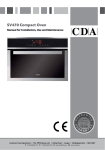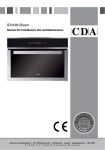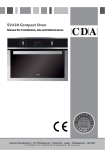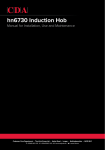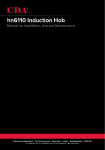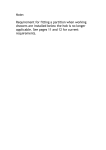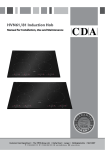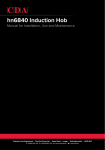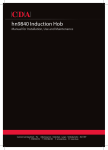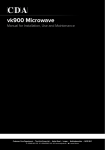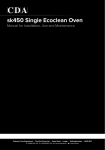Download CDA sk650 Specifications
Transcript
sk650 Single Pyrolytic Oven Manual for Installation, Use and Maintenance Customer Care Department • The Group Ltd. • Harby Road • Langar • Nottinghamshire • NG13 9HY T : 01949 862 012 F : 01949 862 003 E : [email protected] W : www.cda.eu Important This appliance must only be used for the purpose for which it is intended, i.e. domestic cooking, defrosting and reheating foods. Any other use could be dangerous and may lead to premature failure of the appliance. The CDA Group Ltd cannot be held responsible for injuries or losses caused by incorrect use or installation of this product. Please note that CDA reserve the right to invalidate the guarantee supplied with this product following incorrect installation or misuse of the appliance. User information: • Ovens become hot during and immediately after use. Ensure you do not touch the heating elements located inside the appliance. • The oven door can become very hot during operation. • After use, please ensure that the appliance is switched off. • Keep children away from the appliance when in use, and immediately after use. • Keep the oven door closed when in use. Appliance information: Please enter the details on the appliance rating plate below for reference, to assist CDA Customer Care in the event of a fault with your appliance and to register your appliance for guarantee purposes. Appliance Model Serial Number 2 CE Declarations of Conformity: This oven has been designed, constructed and marketed in compliance with safety requirements of EEC Directive 2006/95/EEC (Low voltage) and requirements of EMC Directive 2004/108/EEC. This appliance has been manufactured to the strictest standards and complies with all applicable legislation, including Electrical safety (LVD) and Electromagnetic interference compatibility (EMC). Parts intended to come into contact with food conform to EEC/89/109.4 IMPORTANT INFORMATION FOR CORRECT DISPOSAL OF THE PRODUCT IN ACCORDANCE WITH EC DIRECTIVE 2002/96/EC. At the end of its working life, the product must be taken to a special local authority waste collection centre or to a dealer providing appliance recycling services. Disposing of a household appliance separately avoids possible negative consequences for the environment and health. It also enables the constituent materials to be recovered, saving both energy and resources. As a reminder of the need to dispose of household appliances separately, the product is marked with a crossed-out wheeled dustbin. 3 Important • Do not dismantle any parts withou disconnecting the oven from the mains power supply. • Do not use the appliance if any part is broken (for example a glass). Disconnect it from the mains and call CDA Customer Care. • Before using the oven, it is recommended to run it empty at the maximum temperature for an hour to remove any smells remaining from manufacturing processes. • In all models, leave the door closed when the grill is used. • The cooling fan may continue to run as long as the oven is hot, even after it has been switched off. • During use the appliance becomes very hot; don’t touch the heating elements inside the oven. • During the oven operation, the front is heated as well; consequently keep children clear of the oven, especially during self-cleaning. • Parents and adults should pay particular attention when using the product in presence of children. • Children should be overseen so as to ensure that they don’t play with the equipment. • Keep children under age 8 away, unless constantly supervised. • This appliance is not intended for use by persons (including children over age 8) with reduced physical sensory or mental capabilities, or lack of experience and knowledge, unless they have been given supervision or instruction concerning use of the appliance by a person responsable for their safety. • Children may not perform cleaning and maintenance unsupervised. 4 • In order to avoid damage to the oven enamel coat, do not cover the oven base with any item (e.g. aluminum foil, pans and the likes). • Do not use harsh abrasive cleaners or sharp metal scrapers to clean the oven door glass since they can scratch the surface, which may result in shattering of the glass. • Abrasive detergents and steam cleaning equipment should not be used for cleaning. • Before performing self-cleaning, take out all accessories (grills, dishes, pans) to avoid damaging them, remove large cooking residues and then close the door, ensuring that it is closed properly. • Ensure the oven is cool and power to the oven has been turned off before removing the door. Failure to do so could result in electrical shock or burns. • Read the user instructions carefully before using the oven for the first time. • Follow the instructions for first use of the oven. • Clean the oven regularly. • Remove spills as soon as they occur. • Always use oven gloves when removing shelves and trays from the oven. • Do not grill food containing fat without using the grill pan grid. • Do not cover the grill pan grid or the oven walls with aluminium foil. • Do not use the oven tray for roasting. • Do not perform maintenance or cleaning of the oven without first switching off the electricity supply. If the oven has recently been used, allow to cool. 5 • Do not place hot enamel parts in water. Leave them to cool first. • Do not allow vinegar, coffee, milk, saltwater, lemon or tomato juice to remain in contact with enamel parts. • The oven can require increased ventilation on pyrolytic programmes. This can be achieved either from an open window or the use of a fan. Fig. 1 below shows correct placement of grills. Fig. 1 6 Fitting Out Your Appliance Oven rack positions The oven racks can be positioned in any one of four pairs of guides at differing levels. At each level is a pair of supports formed in the side walls of the oven cavity. • Always be sure to position the oven racks before turning on the oven. • Make sure that the racks are level once they are in position. • The racks are designed to stop when pulled forward to their limit. To remove a rack from the oven 1 Pull rack forward. 2 Lift rack up at front and then pull further forward to remove it. Fig. 2 To replace an oven rack 1 Place rear of rack between rack level guides. 2 While lifting front of rack, slide rack in all the way while lowering the front. Fig. 3 7 The Control Panel Temperature control Digital Display Function control Fig. 3 Digital Display in Detail Time LED Timer indicator Temperature LED Auto cooking indicator Fig. 4 8 Door lock LED Heating LED Auto timing indicator Function Control Knob in Detail Pyrolytic clean Off Light Defrost Full grill Conventional oven Half grill Conventional Eco oven Fanned half grill Fan with lower heat Fan oven Fig. 5 9 Before First Use When the oven is connected to the electrical supply the latch mechanism runs an automatic self-test by locking then unlocking the oven door. This operation takes about half a minute. The “Door lock LED” flashes while this test is performed, then turns off when the test is completed. The same process is repeated after every interruption to the power supply. Clock The clock must be set after connecting the electrical supply, before any cooking functions can be used. The time of day is always displayed in 24 hour format. Note: The “Time LED” is lit whenever the digital display is showing a time value. 10 Setting the clock In order to set the time of day, the “Function control” knob must first be in the “Off” position. • Turn the “Temperature control” knob clockwise or anticlockwise and let it return to its rest position: The hours flash. • Modify the flashing hours value by turning the “Temperature control” knob clockwise or anticlockwise, then let it return. • Push the “Temperature control” knob to set the minutes: The minutes flash. • Modify the flashing minutes value by turning the “Temperature control” knob clockwise or anticlockwise, then let it return. • After a few seconds the whole time display flashes. Once this flashing finishes the time is set. Before using the oven for the first time we recommend that you clean it with soapy water, rinse carefully and then heat on the fan oven setting at maximum temperature for 30 minutes. A slightly unpleasant smell may be produced, caused by grease remaining on the oven elements from the production process. General Settings & Use Note: The “Temperature LED” is lit whenever the digital display is showing a temperature (always °C). To turn the oven on Turn the “Function control” knob to the required programme. The display will briefly show “On” then show the temperature preset for the programme and cooking will start immediately. To change the temperature, turn the “Temperature control” knob clockwise or anticlockwise until the required temperature shows on the display. The “Heating LED” will flash on the display whilst the oven heats up. Once the oven has reached the required temperature, the oven will give five sets of three beeps and the “Heating LED” will light continuously. 11 To turn the oven off Turn the “Function control” knob to the “Off” position, the oven gives three short beeps and the word ”Off” appears briefly on the display. The functions available on the “Function control” knob are: Oven light The oven light may be turned on by turning the “Function control” knob to the “Oven light” position. Alternatively, the oven light will turn on automatically when a cooking programme is selected: it stays off during pyrolytic cleaning. Defrost Turn the “Function control” knob to the “Defrost” position. The defrost programme uses the the fan to circulate air for defrosting. This is not a cooking programme. The display shows “Def”. Conventional oven Turn the “Function control” knob to the “Conventional oven” position. The cooking temperature defaults to 210°C and can be set between 50-250°C in 5˚C increments by turning the “Temperature control” knob. After setting, the temperature can be changed at any time by turning the “Temperature control” knob again. 12 Conventional Eco oven Turn the “Function control” knob to the “Conventional Eco oven” position. In this setting, the oven cooling fan only comes on when the oven is hot, saving some electricity. The cooking temperature defaults to 190°C and can be set between 50-250°C in 5˚C increments by turning the “Temperature control” knob. After setting, the temperature can be changed at any time by turning the “Temperature control” knob again. Fan oven Turn the “Function control” knob to the “Fan oven” position. The fan oven programme allows you to cook and brown foods just as you would in a traditional oven. The cooking temperature defaults to 190°C and can be set between 50-250°C in 5˚C increments by turning the “Temperature control” knob. After setting, the temperature can be changed at any time by turning the “Temperature control” knob again. Fan with lower heat Turn the “Function control” knob to the “Fan with lower heat” position. The fan with lower heat programme uses the fan element to enhance the heat from the bottom element to create an ideal environment for cooking pizzas. The cooking temperature defaults to 190°C and can be set between 50-250°C in 5˚C increments by turning the “Temperature control” knob. After setting, the temperature can be changed at any time by turning the “Temperature control” knob again. 13 Fanned half grill Turn the “Function control” knob to the “Fanned half grill” position. The fanned half grill programme uses the grill element for grilling and the fan to help circulate heat around the food. The cooking temperature defaults to 230°C and can be set between 50-250°C in 5˚C increments by turning the “Temperature control” knob. After setting, the temperature can be changed at any time by turning the “Temperature control” knob again. Half grill Turn the “Function control” knob to the “Half grill” position. The half grill programme uses just the centre grill element to provide top heat for grilling or browning foods. The rack should be placed in as high a position as possible to bring the food close to the element. The food needs to be turned over during cooking to ensure both sides are cooked. The grill should be preheated for approximately two minutes before starting to cook. The cooking temperature defaults to 230°C and can be set between 50-250°C in 5˚C increments by turning the “Temperature control” knob. After setting, the temperature can be changed at any time by turning the “Temperature control” knob again. 14 Full Grill Turn the “Function control” knob to the “Full grill” position. The full grill programme uses the centre and outer grill elements to provide top heat for grilling or browning foods. The rack should be placed in as high a position as possible to bring the food close to the elements. The food needs to be turned over during cooking to ensure both sides are cooked. The grill should be preheated for approximately two minutes before starting to cook. The cooking temperature defaults to 230°C and can be set between 50-250°C in 5˚C increments by turning the “Temperature control” knob. After setting, the temperature can be changed at any time by turning the “Temperature control” knob again. Pyrolytic clean This oven can clean itself by a process known as pyrolysis, heating the cavity to a temperature of approximately 475˚C. This will burn off the residue from spattering and spillages caused by cooking. Pyrolytic programmes should be used when the oven smokes during preheating or cooking or if the oven smells even when cold. It is not necessary to run a pyrolytic programme after every use of the oven. Do not wait until the oven is coated in grease to run a pyrolytic programme. The smoke produced by pyrolysis is broken down by passing through a catalyser. 15 Please note: Before any pyrolytic programme, remove all shelves, trays and other accessories from the oven and clean up any major spills to avoid the risk of fire or excessive smoke. Do not hang towels or cloths on the oven handle during pyrolysis. Turn the “Function control” knob to the “Pyrolytic clean” position. The programme immediately locks the door and starts the cooling fan at a slow setting; the cooling fan speed increases to its maximum when the oven heat builds up. The digital display shows “P1:30”, the preset time of one hour and is activated. The thirty minutes. Also the “Auto timing indicator” “Door lock” LED shows the status of the door lock at any time: Off: Flashing: Full on: Door unlocked Door being locked / unlocked Door locked The time for pyrolysis defaults to 90 minutes and can be set between 60-180 minutes in 15 minute increments . To change the time, after setting the “Function control” knob: • Press the “Temperature control” knob twice; the display shows the time in minutes. • Turn the “Temperature control” knob clockwise or anticlockwise to select the time required. • Approximately ten seconds after releasing the “Temperature control” knob the display reverts to hours and minutes and stops flashing. 16 • It is now set at the revised time. When the pyrolytic clean finishes the display shows “P---” and the “Auto timing indicator” flashes. • The display is cleared when the “Function control” knob is turned to the off position. • The door remains locked until the inside of the oven drops below the safety threshold. When the oven is cool: • Disconnect the appliance from the power supply. • Use a damp cloth to remove the white ashes from within the oven. The oven is ready for use once the power supply is reconnected. 17 Timer and Minute Minder Timer functions are selected by pressing the “Temperature control” knob. This switches the digital display between them:Clock function: The display shows the current time. Minute minder function: The display shows a countdown time until the oven beeps. Duration function: The display alternates between the word “dur” and the setting for cooking duration. End function: The display alternates between the word “End” and the setting for the cooking end time. Note: if the “Temperature control” knob is not touched for approximately ten seconds the display will revert back to showing the current time. Programming the oven Any timer functions required should be set after the relevant cooking programme has been set. Timer - Cooking time • Press the “Temperature control” knob twice: The display then shows the word “dur”. • Turn the “Temperature control” knob clockwise or anticlockwise to select the time required. This defaults to 30 minutes and can be set to any time in the range 0-240 minutes. • After approximately fifteen seconds the display reverts back to 18 showing the current time. The “Auto timing indicator” and the “Auto cooking indicator” illuminate. • The timer is now set. • At the end of the set time, the oven switches off and the beeper sounds. • The beeper can be silenced by briefly turning the “Temperature control” knob clockwise or anticlockwise, then letting it return to its rest position. Timer - End time • Press the “Temperature control” knob three times: The display then shows the word “End” alternating with the current time (the end time defaults to the current time). • Turn the “Temperature control” knob clockwise or anticlockwise and let it return to its rest position: The hours flash. • Modify the flashing hours value by turning the “Temperature control” knob clockwise or anticlockwise, then let it return. • Push the Temperature control” knob to switch to setting the minutes: The minutes flash. • Modify the flashing minutes value by turning the “Temperature control” knob clockwise or anticlockwise, then let it return. • After approximately fifteen seconds the display reverts back to and the showing the current time. The “Auto timing indicator” “Auto cooking indicator” illuminate. • The timer is now set. • The cooking time automatically updates in line with this. • At the end of the set time, the oven switches off and the beeper sounds. 19 • The beeper can be silenced by briefly turning the “Temperature control” knob clockwise or anticlockwise, then letting it return to its rest position. Programming delayed cooking This is achieved by programming an end time (when you want the food ready) and also programming a cooking time (as the recipe). Minute minder The minute minder is a timer that is independent of the function of the oven; it times and sounds a beep but does not affect any oven functions. This is useful for timing actions that are unrelated to this appliance, for example timing eggs on the hob. • Press the “Temperature control” knob once: The display then shows “---”. • Turn the “Temperature control” knob clockwise or anticlockwise to select the time required. This defaults to 30 minutes and can be set to any time in the range 0-240 minutes. • After approximately fifteen seconds the display reverts back to showing the current time. The “Timer indicator” illuminates. • The minute minder is now set. • At the end of the set time, the beeper sounds. • The beeper can be silenced by briefly turning the “Temperature control” knob clockwise or anticlockwise, then letting it return to its rest position. 20 Care and Maintenance IMPORTANT: Always disconnect the appliance from the power supply before undertaking any cleaning or maintenance. You should always allow the oven to cool fully after use before undertaking any cleaning or maintenance. Changing the oven lamp • Remove all shelves and the grill pan from the oven. • Remove the glass cover (Fig.6 item 1) by unscrewing it. • Carefully remove the old bulb (Fig. 6 item 2) and insert a new bulb, suitable Fig. 6 for high temperatures (300ºC) having the following specifications: 230240V, 50Hz, 25W. • Insert the new bulb taking care not to touch the glass with your hands as contamination from your fingers can cause premature failure. Always use a clean cloth or gloves. • Reattach the glass cover, by screwing it back into position. • Replace the oven shelves and grill pan as necessary. Please note: Bulb replacement is not covered by your guarantee. 21 Oven Door Removal For Cleaning Fig. 7 Fig. 8 To remove the oven door (Fig. 7) 1 Open the door completely. 2 Lift the hinge bracket (1). 3 Hold the door firmly on both sides using both hands and close it as far as the stops. 4 Pull the door out, holding it firmly because it is heavy. 5 Place the door in a safe and convenient location. To re-install the oven door (Fig. 8) 1 Insert the arms (2) of both hinges in the slots (3). The corners (4) must engage the edges (5). 2 Move the hinge brackets (1) back down into position. 3 Close and open the door slowly to assure that it is correctly located and securely in place. 22 Door Glass Removal and Replacement Note: Suitable protective gloves should be worn for this process. • Remove the door, as above and lie it, face down, on a firm surface, protected with a soft cloth. • Press the buttons on the two side covers at the same time to release and remove the upper strip (Fig.9). Lay it safely aside. • Slide out the pack of 3 panes of internal glass as shown (Fig. 10). • The second and third panes of glass (middle panes) can then be individually removed for cleaning. • After cleaning, replace the middle panes, reversing the removal process. Check that they are oriented so the words “INTERNAL SIDE” are visible correctly (Fig. 11). Fig. 9 Fig. 10 Fig. 11 23 Cleaning You should only use non-abrasive cleaners. Any abrasive cleaners (including Cif) will scratch the surface and could erase the control panel markings. You should not use cleaning products with a chlorine or acidic base. Any spillages should be cleaned off immediately, especially any alkaline or acidic substances (lemon juice, vinegar etc.). Stainless steel Stainless steel can be effectively cleaned by simply using a dilute solution of water and mild detergent and drying to a shine with a clean cloth. Proprietary stainless steel cleaners are available. We recommend the CDA E-Cloth available from the CDA Sales Team for cleaning stainless steel surfaces. Enamelled parts All enamelled parts must be cleaned with a sponge and soapy water only, or other non-abrasive products. Suitable proprietary chemical cleaners may be used after first consulting with the manufacturer’s recommendations and testing a small sample on the oven cavity. Inside the oven It is recommended that the interior of the oven be cleaned after every use using suitable products, especially if any spillage has occurred. The shelves can be removed and washed by hand or in the dishwasher. When used regularly, the grill element does not need cleaning as the 24 intense heat will burn off any splashes. The interior ceiling may need regular cleaning, which should be done with warm water, detergent and a sponge. If the grill is not used regularly, it should be run for 10 minutes every month to burn off any splashes, in order to reduce the risk of fire. PLEASE NOTE: Steam cleaners must not be used to clean this appliance. Do not store flammable material in the oven. Do not allow grease or food particles to build up around the door. IMPORTANT: When correctly installed, your product meets all safety requirements laid down for this type of product. However, special care should be taken around the rear or the underneath of the appliance as these areas are not designed or intended to be touched and may contain sharp or rough edges that could cause injury. Display and Failure Codes Your oven is equipped with diagnostic systems which monitors its performance and will display fault codes in the event that it detects a fault. All repairs which must be done on the oven should only be performed by authorised service agents. When a repair is required or you are unable to eliminate the failure with the help of the information given below: 25 • Switch off (or disconnect) the power supply to the appliance. • Contact CDA Customer Care. Fault Code Fault description E1 Temperature sensor faulty E2 Temperature sensor short circuit E4 Temperature sensor circuit failure E8 Latch time excessive E64 Mode selector disconnected OTHERS The sum of a combination of the above codes Installation The appliance can be installed under a worktop or in a wall unit (open at the rear) with the appropriate dimensions for recessed installation. Do not use your appliance immediately after moving it from a cold location, as condensation may cause a malfunction. Wait approximately 1-2 hours before use. Centre the oven in the unit. The material of the unit supporting the appliance must be heat resistant (or covered with a heat resistant material). For greater stability, attach the oven to the unit with two screws through the holes provided on the side panels. If the appliance is to be installed under a worktop, ensure the top rail has been removed to provide free airflow around the product. If the oven is to be installed in a tall unit, air gaps of at least 200 cm2 must be left for air circulation, as Fig. 12. 26 Fig. 12 27 Mains Electricity Connection Warning! This appliance must be earthed Fig. 13 fig. 8 We recommend that the appliance is connected by a qualified electrician, who is a member of the N.I.C.E.I.C. and who will comply with the I.E.T. and local regulations. This appliance is intended to be connected to fixed wiring and is not suitable for connection to a 13A plug or 13A supply. This appliance is intended to be connected to fixed wiring by a double pole switch, having a contact separation of at least 3mm in all poles. The switch must be positioned no further than 2m from the appliance. 28 This appliance is supplied with a 3 core mains cable; the wires are in accordance with the following code: Green and Yellow = Earth Blue = Neutral Brown = Live Please note: • The mains cable must only be replaced by a qualified electrician or service engineer and must be of equivalent or better rating (i.e. 3x1.5mm2, HO5V2V2-F). • The rating of the fuse or circuit breaker protecting this appliance should be marked on the socket outlet. Use a 16A fuse. • Assembly and electrical connection should be carried out by specialised personnel. • When installing this product we recommend you seek the help of another individual. The mains isolation switch must be accessible after installation. Mains electrical voltage: 230Vac, 50 Hz Total rated electrical consumption: 3.0 kW 29 30 E & O E. All instructions, dimensions and illustrations are provided for guidance only. CDA reserve the right to change specifications without prior notice. 31 Please contact our Customer Care Department for Service on the details below. Customer Care Department • The Group Ltd. • Harby Road • Langar • Nottinghamshire • NG13 9HY T : 01949 862 012 F : 01949 862 003 E : [email protected] W : www.cda.eu © CDA 2014
































